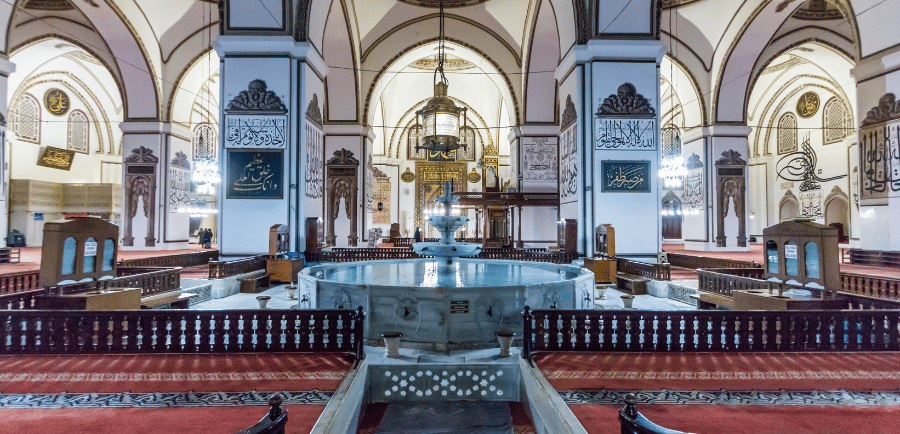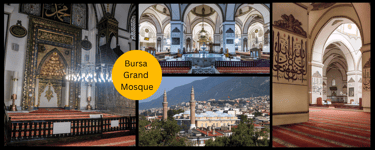Bursa Grand Mosque (Bursa Ulu Cami)
As one of Islam's esteemed places of worship, Bursa Grand Mosque stands among the five revered destinations for Muslims worldwide. Its architectural splendor, adorned with celestial motifs and intricate calligraphy, reflects a rich blend of Seljuk and Ottoman heritage. A symbol of spiritual reverence, it houses sacred relics, including the historic Kaaba cover, enriching its cultural and religious significance.


Bursa Grand Mosque(Bursa Ulu Cami)
Discover the Majesty of Bursa Grand Mosque (Ulu Cami)
A Harmonious Blend of History & Architecture
When Bursa is mentioned, the iconic structure that immediately comes to mind is the Grand Mosque, situated on Atatürk Street in the city center. Recognized as the quintessential example of the multi-footed mosque design, the Bursa Grand Mosque was commissioned by the 4th Ottoman Sultan, Yıldırım Bayezid, in 1399, showcasing influences from both the Seljuk and Ottoman eras. Comprising five sections, the Ulu Mosque boasts 20 domes, with a central glass dome that bathes the mosque in natural light. Adorned with intricate calligraphy, the interior features an 18-cornered fountain beneath the glass dome, making it one of Turkey's largest prayer spaces.
After the mosque's completion, the inaugural prayer was led by the esteemed Islamic scholar Somuncu Baba (Sheyh Hamid-i Vali), alongside Sultan Yıldırım Bayezid and other prominent figures of the time, including Molla Fenari (full name: Mulla Shams ad-Din Muhammad ibn Hamzah al-Fanari) and Emir Sultan (Amir Sultan / full name: Sayed Shamsuddin Mohamed Bin Ali Al-Hussain Al-Bukhari). The first imam of the Grand Mosque was Süleyman Çelebi, a respected scientist and poet known for his literary work, Mevlid, which recounts the birth of the Islamic prophet Muhammad and provides brief insights into his life.
An intriguing feature of the Bursa Grand Mosque, located in the heart of the city with its two minarets, is the depiction of the solar system on its pulpit. The eastern side of the pulpit illustrates the solar system, while the western side showcases the galaxy system. Crafted with meticulous detail, the pulpit is made from 6666 wooden pieces, symbolizing the number of verses in the Quran. Ten reliefs, intricately carved using the Kundekari technique from walnut trees, represent the order and size of planets in the solar system, aligning with their actual proportions. In this context, the Ulu Mosque transcends being a mere place of worship, emerging as a marvelous piece of art that incorporates mathematics and astronomy.


The minber, a stepped platform in mosques used by orators during sermons, and the Kundekari Technique, an art form of joining wood without using nails or adhesives, add unique elements to the Grand Mosque's architecture. Another significant aspect is the presence of 192 writings on its walls and pillars/columns, showcasing impressive examples of calligraphy by world-famous master calligraphers. Among these, 87 are fixed, and 105 are in plate form, featuring verses from the Quran, including Fatiha, İhlas, and Nas, along with Ayet’el-Kürsi in three different styles, verses with the names of the prophet Allah and Mohammed, and writings dedicated to elders of Islam.
According to some Islamic clergy, the Bursa Grand Mosque is considered one of the five most important places of worship in Islam. The other four are the Kaaba in Mecca, the Masjid Al-Nabawi in Medina, the Masjid Al-Aqsa Mosque in Jerusalem, and the Umayyad Grand Mosque in Damascus. One of the significant treasures in the Grand Mosque is the Kaaba cover. After the transfer of the caliphate to the Ottoman Empire following Yavuz Sultan Selim's Egyptian Expedition, sacred relics were brought to Istanbul's Topkapı Palace. Yavuz Sultan Selim entrusted the Kaaba cover, one of these sacred relics, to Bursa, where it has been housed in the Grand Mosque since that day.
